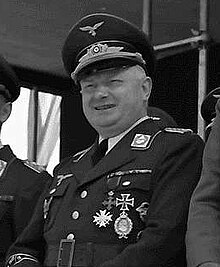
Summary
Alfred Gerstenberg (6 April 1893 – 1 January 1959, in Bad Tölz) was a German Luftwaffe general. During World War II, he served as commanding general of the Luftwaffe mission to Romania and organized a very effective defensive perimeter around oil fields in Ploiești.
Alfred Gerstenberg | |
|---|---|
 Alfred Gerstenberg in Bucharest, May 1943 | |
| Born | 6 April 1893 Grainau, German Empire |
| Died | 1 January 1959 (aged 65) Bad Tölz, West Germany |
| Allegiance | |
| Service/ | Prussian Army (1912–18) Reichsheer (1918–26) Luftwaffe (1934–45) |
| Years of service | 1912–26 1934–45 |
| Rank | Generalleutnant |
| Battles/wars | World War I World War II |
Career edit
Gerstenberg began his army service in 1912 in a cavalry unit. During World War I he was sent to the Eastern Front. Later, he was transferred into the air force and flew as an observation aircraft pilot. In 1916, he joined the Richthofen Squadron led by Manfred von Richthofen. In October 1917, his plane was shot down and Gerstenberg suffered a heavy injury. Next year, he returned as a non-flying officer. After the war served in several cavalry units, retiring in 1926. He rejoined the Luftwaffe in 1934 and after 1938 served as Luftwaffe attaché at embassies in Warsaw and Bucharest.
World War II edit
From 15 February 1942 to 27 August 1944, Gerstenberg served as the commanding general of Luftwaffe in Romania (Kommandierender General und Befehlshaber der Deutschen Luftwaffe in Rumänien). His most important task was to set up a defense zone around the oil refineries in Ploiești, the largest single source of oil for Nazi Germany. He managed to create an effective anti-aircraft defense system against air attacks. He commanded around 25,000 men in Ploiești and 11,000 near Bucharest. As a result, the first massive air attack on the fields on 1 August 1943 (US Army Air Forces Operation Tidal Wave) failed to knock out the oil production and suffered heavy losses.
In the night of 23/24 August, after King Michael's coup d'état, Gerstenberg together with General Erick-Oskar Hansen and Ambassador Manfred von Killinger met up with General Constantin Sănătescu, the new Prime Minister of Romania. In the meeting, General Sănătescu offered the Germans safe passage to the Hungarian border, to which the German officials agreed. General Gerstenberg was to be escorted by Colonel Valeriu Selescu while passing through the capital on his way to Ploiești. However, once in Băneasa, Gerstenberg had the Romanian officer arrested. With the orders received from Adolf Hitler, he then began to enact Operation Margarethe II, the plan to invade Romania in case the government surrendered to the Allies. With some 4,000 men under his command,[1] Gerstenberg occupied the airports of Băneasa and Otopeni from where Luftwaffe aircraft began bombing Bucharest.[2][3][4]
On 25 August, after Romania officially declared war on the Axis, he was replaced in command by Reiner Stahel. The plan still failed and German troops were encircled, in spite of Brandenburgers paratroopers dropped in as a support. On 26 August, the German positions were bombed by the USAAF, and Romanian troops eventually occupied the airports. On 28 August, he was arrested by Romanian soldiers together with General Stahel at Gherghița. The two were brought in the barracks opposite the Military Hospital in Bucharest.[3][4]
After the war edit
On 2 September 1944,[5] Gerstenberg was taken by the Soviets to Moscow. He was kept in captivity in the Butyrka, Lefortovo and Vladimir prisons. Sentenced to 25 years of prison by military tribunal in 1952, he was released on 12 October 1955 and handed over to the authorities of the Federal Republic of Germany.[6][7] He died of tuberculosis in Bad Tölz on 1 January 1959.
Awards and decorations edit
- Iron Cross (1914)
- 2nd Class
- 1st Class
- Wound Badge in Black (1914)
- Knight's Cross of the Royal House Order of Hohenzollern with Swords
- Honour Cross of the World War 1914/1918
- Order of Aeronautical Virtue Commander class (4 November 1941)
- Order of Michael the Brave 3rd Class (3 March 1943)
References edit
- ^ Axworthy, Mark (1995). Third Axis, Fourth Ally: Romanian Armed Forces in the European War, 1941–1945. London: Arms and Armour. pp. 189–191.
- ^ Florin Sperlea. "Cat valoreaza onoarea pe campul de lupta?". presamil.ro (in Romanian). Archived from the original on 19 January 2008.
- ^ a b Nicolae Jurca. "Serata de adio s-a contramandat". memoria.ro (in Romanian). Retrieved 18 February 2024.
- ^ a b Narcis I. Gherghina. "Bombardamentele germane asupra Bucureștiului: 23-26 august 1944". aviatori.ro (in Romanian). Retrieved 18 February 2024.
- ^ Teofil Oroian. "Cum au răpit sovieticii prizonierii capturați de armata română". Historia. Retrieved 26 March 2024.
- ^ "Герстенберг, Альфред Георг" (in Russian). Retrieved 18 February 2024.
- ^ Konstantin Zalesskij (2005). Люфтваффе. Военно-воздушные силы Третьего рейха (in Russian). ISBN 9785699137688.
External links edit
- Short biography
- Overview of military career
Bibliography edit
- Hillgruber, Andreas (1965): Hitler, König Carol und Marschall Antonescu: die deutsch-rumänischen Beziehungen 1938–1944, Wiesbaden: Steiner.


